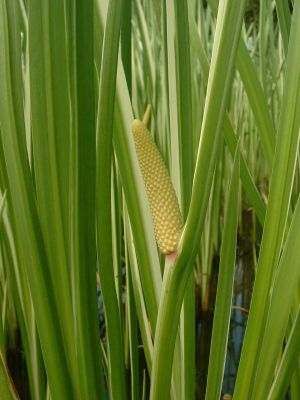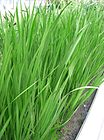Note: This is a project under development. The articles on this wiki are just being initiated and broadly incomplete. You can Help creating new pages.
Difference between revisions of "Acorus calamus - Jatila"
| (53 intermediate revisions by 2 users not shown) | |||
| Line 1: | Line 1: | ||
| − | |||
| − | |||
[[File:Acorus calamus1.jpg|thumb|right|''Bhutanashini'']] | [[File:Acorus calamus1.jpg|thumb|right|''Bhutanashini'']] | ||
| − | + | '''Jatila''' is a tall perennial wetland monocot of the Acoraceae family, in the genus Acorus. The scented leaves and more strongly scented rhizomes have traditionally been used medicinally and to make fragrances, and the dried and powdered rhizome has been used as a substitute for [[Ginger]], [[Sthula tvak]] and nutmeg. This plant is belongs to Aracea family.<ref name="Plant family"/> | |
| − | |||
| − | |||
==Uses== | ==Uses== | ||
| − | {{Uses| | + | {{Uses|Epilepsy}}, {{Uses|Oedema}}, {{Uses|Scrotal enlargement}}, {{Uses|Skin diseases}}, {{Uses|Headache}}, {{Uses|Alopecia}}, {{Uses|Wounds}}, {{Uses|Diarrhea}}, {{Uses|Eye diseases}}, {{Uses|Acid gastritis}}, {{Uses|Heart problems}} |
==Parts Used== | ==Parts Used== | ||
| − | {{Parts Used| | + | {{Parts Used|Rhizome}}, {{Parts Used|Roots}}. |
==Chemical Composition== | ==Chemical Composition== | ||
| − | + | Both triploid and tetraploid A. calamus contain alpha-asarone. Other phytochemicals include beta-asarone, eugeno and Diploids do not contain beta-asaronel<ref name="chemical composition"/> | |
==Common names== | ==Common names== | ||
| − | {{Common names|kn=|ml=|sa=|ta=|te=|hi=|en= | + | {{Common names|kn=Athibaje, Baje, Baje gida|ml=Vaembu, Vashampa|sa=Bacha, Bhadra, Bhutanashini|ta=Akaraveci, Akkitam|te=Vadaja, Vasa|hi=Bacc, Bach|en=}} |
==Habit== | ==Habit== | ||
| Line 22: | Line 18: | ||
==Identification== | ==Identification== | ||
===Leaf=== | ===Leaf=== | ||
| − | {{Leaf|Simple||The leaves are | + | {{Leaf|Simple|Ensiform|The leaves are erect and flat and sword-like, bright green, rising fan-like from a pinkish base although some bases may range from white to red in color}}<ref name="Leaf"/> |
===Flower=== | ===Flower=== | ||
| − | {{Flower| | + | {{Flower|Spadix||Yellowish-green|6 petal|The tepals can be a light brown in color, are very small with squarish tips}} |
===Fruit=== | ===Fruit=== | ||
| − | {{Fruit|| | + | {{Fruit|Berry|||Green, angular, 3-celled, fleshy, containing 1-3 oblong seeds|}} |
===Other features=== | ===Other features=== | ||
==List of Ayurvedic medicine in which the herb is used== | ==List of Ayurvedic medicine in which the herb is used== | ||
| − | * [[ | + | * [[Kolakulathadi churna]] |
| + | * [[Manasamitra vatakam]] | ||
| + | * [[Brahmi vati]] | ||
| + | * [[Chandrodaya varti]] | ||
| + | <ref name="Ayurvedic preparations"/> | ||
==Where to get the saplings== | ==Where to get the saplings== | ||
==Mode of Propagation== | ==Mode of Propagation== | ||
| − | {{Propagation| | + | {{Propagation|Rhizomes}}. |
==How to plant/cultivate== | ==How to plant/cultivate== | ||
| − | + | Grows best in tropical/subtropical conditions. Field is prepared similar to paddy, with waterlogging and farmyard manure and the rhizomes are planted.<ref name="How to plant/cultivate"/> | |
| − | |||
==Commonly seen growing in areas== | ==Commonly seen growing in areas== | ||
| − | {{Commonly seen| | + | {{Commonly seen|North temperate hemisphere}}, {{Commonly seen|Tropical asia}}, {{Commonly seen|Himalayas}}. |
==Photo Gallery== | ==Photo Gallery== | ||
<gallery class="left" caption="" widths="140px" heights="140px"> | <gallery class="left" caption="" widths="140px" heights="140px"> | ||
| − | File: | + | File:Acorus calamus2.jpg|Leaves |
| − | File: | + | File:Acorus calamus kz1.JPG|Leaf |
| − | + | File:Acorus calamus 2019-04-16 1125.jpg|Rhizome | |
| − | + | File:Acorus calamus seeds.jpg|Seeds | |
| + | File:AcorusCalamus2.jpg|Flowers | ||
| + | File:Acorus calamus1 (5097239953).jpg|Flowers | ||
</gallery> | </gallery> | ||
==References== | ==References== | ||
| − | |||
<references> | <references> | ||
| − | <ref name="chemical composition">[https:// | + | <ref name="chemical composition">[https://en.wikipedia.org/wiki/Acorus_calamus Chemistry]</ref> |
| − | <ref name="Leaf">[ | + | <ref name="Leaf">[http://www.friendsofthewildflowergarden.org/pages/plants/sweetflag.html Leaves description]</ref> |
| − | <ref name=" | + | <ref name="Ayurvedic preparations">[https://easyayurveda.com/2015/01/06/vacha-acorus-calamus-uses-research-side-effects-remedy/ Ayurvedic preparations]</ref> |
| − | <ref name="How to plant/cultivate">[http:// | + | <ref name="How to plant/cultivate">[http://nopr.niscair.res.in/bitstream/123456789/9381/1/NPR%203%281%29%2019-21.pdf Cultivation details]</ref> |
| + | <ref name="Plant family">Karnataka Aushadhiya Sasyagalu By Dr.Maagadi R Gurudeva, Page no:233</ref> | ||
</references> | </references> | ||
==External Links== | ==External Links== | ||
| − | + | * [http://www.techno-preneur.net/technology/project-profiles/food/sweet.html Sweet Flag Agrotechnology] | |
| + | * [http://www.primaryinfo.com/acorus-calamus.htm Acorus Calamus-Primary Information Services] | ||
[[Category:Herbs]] | [[Category:Herbs]] | ||
| + | [[Category:Acoraceae]] | ||
Latest revision as of 16:33, 11 August 2020
Jatila is a tall perennial wetland monocot of the Acoraceae family, in the genus Acorus. The scented leaves and more strongly scented rhizomes have traditionally been used medicinally and to make fragrances, and the dried and powdered rhizome has been used as a substitute for Ginger, Sthula tvak and nutmeg. This plant is belongs to Aracea family.[1]
Contents
Uses
Epilepsy, Oedema, Scrotal enlargement, Skin diseases, Headache, Alopecia, Wounds, Diarrhea, Eye diseases, Acid gastritis, Heart problems
Parts Used
Chemical Composition
Both triploid and tetraploid A. calamus contain alpha-asarone. Other phytochemicals include beta-asarone, eugeno and Diploids do not contain beta-asaronel[2]
Common names
| Language | Common name |
|---|---|
| Kannada | Athibaje, Baje, Baje gida |
| Hindi | Bacc, Bach |
| Malayalam | Vaembu, Vashampa |
| Tamil | Akaraveci, Akkitam |
| Telugu | Vadaja, Vasa |
| Marathi | NA |
| Gujarathi | NA |
| Punjabi | NA |
| Kashmiri | NA |
| Sanskrit | Bacha, Bhadra, Bhutanashini |
| English |
Habit
Identification
Leaf
| Kind | Shape | Feature |
|---|---|---|
| Simple | Ensiform | The leaves are erect and flat and sword-like, bright green, rising fan-like from a pinkish base although some bases may range from white to red in color |
Flower
| Type | Size | Color and composition | Stamen | More information |
|---|---|---|---|---|
| Spadix | Yellowish-green | 6 petal | The tepals can be a light brown in color, are very small with squarish tips |
Fruit
| Type | Size | Mass | Appearance | Seeds | More information |
|---|---|---|---|---|---|
| Berry | Green, angular, 3-celled, fleshy, containing 1-3 oblong seeds | {{{6}}} |
Other features
List of Ayurvedic medicine in which the herb is used
Where to get the saplings
Mode of Propagation
How to plant/cultivate
Grows best in tropical/subtropical conditions. Field is prepared similar to paddy, with waterlogging and farmyard manure and the rhizomes are planted.[5]
Commonly seen growing in areas
North temperate hemisphere, Tropical asia, Himalayas.
Photo Gallery
References
- ↑ Karnataka Aushadhiya Sasyagalu By Dr.Maagadi R Gurudeva, Page no:233
- ↑ Chemistry
- ↑ Leaves description
- ↑ Ayurvedic preparations
- ↑ Cultivation details
External Links
- Ayurvedic Herbs known to be helpful to treat Epilepsy
- Ayurvedic Herbs known to be helpful to treat Oedema
- Ayurvedic Herbs known to be helpful to treat Scrotal enlargement
- Ayurvedic Herbs known to be helpful to treat Skin diseases
- Ayurvedic Herbs known to be helpful to treat Headache
- Ayurvedic Herbs known to be helpful to treat Alopecia
- Ayurvedic Herbs known to be helpful to treat Wounds
- Ayurvedic Herbs known to be helpful to treat Diarrhea
- Ayurvedic Herbs known to be helpful to treat Eye diseases
- Ayurvedic Herbs known to be helpful to treat Acid gastritis
- Ayurvedic Herbs known to be helpful to treat Heart problems
- Herbs with Rhizome used in medicine
- Herbs with Roots used in medicine
- Herbs with common name in Kannada
- Herbs with common name in Hindi
- Herbs with common name in Malayalam
- Herbs with common name in Tamil
- Herbs with common name in Telugu
- Herbs with common name in Sanskrit
- Habit - Herb
- Index of Plants which can be propagated by Rhizomes
- Herbs that are commonly seen in the region of North temperate hemisphere
- Herbs that are commonly seen in the region of Tropical asia
- Herbs that are commonly seen in the region of Himalayas
- Herbs
- Acoraceae






